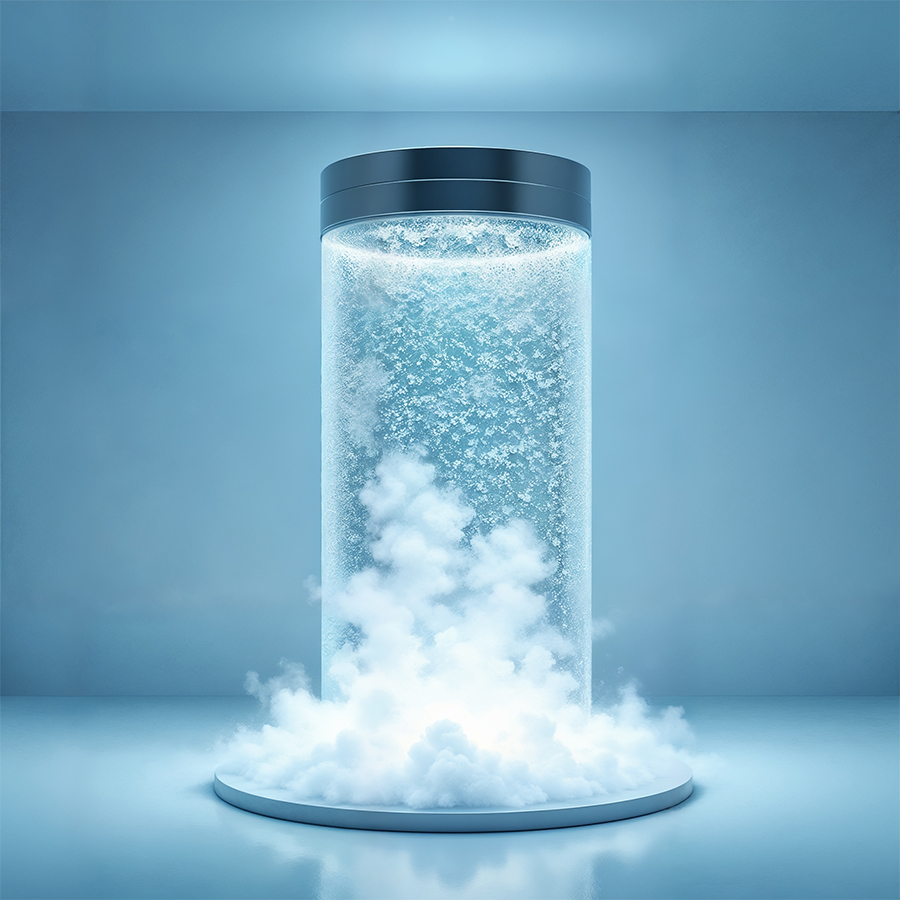
Cryogenic cooling
Cryogenic cooling uses extremely low temperatures, usually through the use of liquid nitrogen (−196 °C). In mechanical engineering, it is used when metal workpieces need to be brought into a detachable press fit. This allows shaft-hub connections or precision plug connections to be joined or detached without tolerance. This technology is also used in the assembly of machine tool components.
Cryogenic cooling also plays an important role in process engineering.
- It is used when the particles of a powder mixture have been coated with liquid fat. In the next step, the powder is cryogenically cooled in the mixer, which makes it free-flowing again.
- Cryogenic cooling is also used when powders, suspensions or pastes have to be processed in a deep-cold state. Pharmaceutical active ingredients, biotechnological fermentation products or food raw materials are sometimes flash-frozen to preserve their structure and activity. The resulting deep-cold ‘powder/granulate’ can then be mixed, pressed or freeze-dried.
In both cases, it is advantageous to use amixon® mixing technology. Due to the gentle mixing process, only a minimal amount of energy is required.
In order for such a mixing process to be reproducible at cryogenic temperatures, the parts of the mixer that come into contact with the product must also be pre-cooled accordingly. Cooling is typically achieved by spraying liquid nitrogen into the mixing chamber. The nitrogen evaporates instantly and extracts large amounts of heat from the equipment. This allows the desired process temperature to be reached within a short time.
For reasons of energy efficiency and cost savings, high-quality insulation of the mixer/reactor is crucial. amixon® process equipment is designed to carry out cryogenic processing reliably, gently and economically. They have a long service life. Typical batch sizes range from 200 to 3000 litres, depending on the product and industry.
Approximate calculation of the amount of liquid nitrogen required to cool 1 kg of stainless steel (1.4404) from +20 to -60°C:
The specific heat capacity of stainless steel 1.4404 is approximately 0.5 kJ/kg·K. We can calculate the energy Q required to cool the plate:
Q = m × c × ΔT
where:
- Q is the energy required,
- m is the mass of the plate (1 kg),
- c is the specific heat capacity (0.5 kJ/kg·K),
- ΔT is the temperature difference (+20°C to -60°C, i.e. 80 K).
Q = 1 kg × 0.5 kJ/kg·K × 80 K = 40 kJ
Now we need to calculate the amount of liquid nitrogen required to absorb this energy. The latent heat of liquid nitrogen is approximately 199 kJ/kg.
The required mass of liquid nitrogen can be calculated as follows:
m = Q / L
where
- m is the mass of liquid nitrogen,
- Q is the energy required (40 kJ),
- L is the latent heat of liquid nitrogen (199 kJ/kg).
Under ideal conditions, the required amount of liquid nitrogen is:
m = 40 kJ / 199 kJ/kg ≈ 0.201 kg
This value is only an approximation, as losses and other factors that could influence the process are not taken into account. In addition, this calculation assumes that the nitrogen evaporates completely and absorbs all the latent heat without the gaseous nitrogen being heated further.
